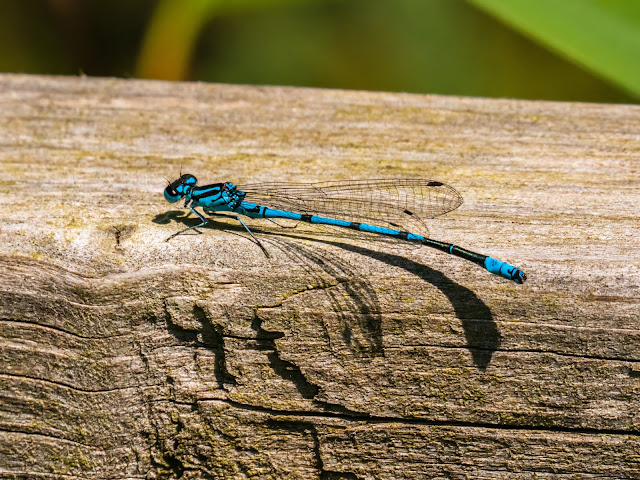Today, I had a visit to RSPB Strumpshaw Fen by public transport (bus to Chelmsford, train to Norwich, bus to Strumpshaw). It was a long day and very hot but thoroughly worth it.
RSPB Strumpshaw Fen is part of the Mid-Yare Valley along with Surlingham, Rockland, Buckenham and Cantley in the Norfolk Broads. The valley protects a mosaic of wetland habitats which is home to a wide range of important species.
RSPB Strumpshaw Fen has the designations Site of Special Scientific Interest , Special Protection Area and Special Area of Conservation. It has the full range of broadland habitats including reedbeds, wet woodlands, wet grasslands, ponds and ditches and orchid-rich meadows.
Photo: RSPB Strumpshaw Fen - view from the visitor centre
I spent almost 6 hours at RSPB Strumpshaw Fen with Swallowtail and Norfolk Hawker being my 2 principal target species to see and photograph.
The Swallowtail is one of the UK's rarest and largest butterflies. The British race britannicus is a specialist of wet fenland and is currently restricted to the Norfolk Broads. It probably declined within its range during the 20th century, especially after the Second World War, but it has benefited over the last few decades from active conservation management of fenland, where reed and sedge are cut to allow other plants to grow.
RSPB Strumpshaw Fen is one of a number of locations in the Norfolk Broads where the Swallowtail can be seen during its flight period .... BBC News .... Swallowtail butterfly enthusiasts flock to Strumpshaw
I did manage (eventually) to see a single Swallowtail during my visit, albeit the view was brief and distant. Therefore, I failed to get a photo but here is one of this spectacular butterfly from the Norfolk Wildlife Trust website ....
During my visit, I recorded the following butterfly species: Swallowtail (1), Brimstone (1), Red Admiral (3), Meadow Brown (2), Large White (1)
I was very successful in seeing and photographing Norfolk Hawkers and they were very conspicuous across RSPB Strumpshaw Fen. I saw at least 20 individuals and they occasionally provided photo opportunities when they ceased hawking for insects and rested up.
The very hot weather meant that there was an abundance of dragonflies and damselflies on the wing, many of which went unidentified. However, in addition to the Norfolk Hawker, Banded Demoiselle, Hairy Dragonfly and Scarce Chaser were the most notable species that I saw.
During my visit, I recorded the following dragonfly and damselfly species: Norfolk Hawker (at least 20), Banded Demoiselle (5), Hairy Dragonfly (at least 5), Scarce Chaser (at least 5), Four-spotted Chaser (at least 20), Large Red Damselfly (1), Red-eyed Damselfly (3), Azure Damselfly (at least 200 and probably significantly more .... all "blues" assumed to be this species given that I obtained no photos of Common Blue Damselfly), Blue-tailed Damselfly (at least 10)
With regard to birds, it was generally hard work. Bird song has subsided as the breeding season progresses and the hot weather inevitably reduced activity.
However, the main highlight was a "reeling" male Grasshopper Warbler, which provided extended views and my best for many years of this elusive species, plus a single Barn Owl hunting over the meadow, a very distant Red Kite and several Marsh Harriers.
Photo: male Grasshopper Warbler
During my visit, the most notable bird species that I recorded were as follows: Grasshopper Warbler (1 “reeling” male), Reed Warbler (2 seen and at least 10 other singing males heard), Sedge Warbler (2 seen and at least 5 other singing males heard), Willow Warbler (4 singing males heard), Common Whitethroat (1 singing male heard), Blackcap (5 singing males heard), Chiffchaff (1 singing male seen and 4 other singing males heard), Swallow (4), Cuckoo (1 calling male heard), Bearded Tit (2 plus several others heard calling), Reed Bunting (1 male seen and 3 other singing males heard), Cetti’s Warbler (3 singing males heard), Barn Owl (1), Red Kite (1), Marsh Harrier (3), Common Buzzard (1 heard calling), Great Crested Grebe (1), Moorhen (1), Coot (1), Mallard (2), Gadwall (1), Grey Heron (1)
#DefendNature .... Please help save and enhance our laws that protect our environment and wildlife
💚🦆 🦉🦋🐝🦊🦡🌼 🌳💚
Stay safe, stay well, stay strong, stay connected with nature





.JPG)
















































No comments:
Post a Comment
If you feel like commenting on my blog, you can contact me by completing the comment form below. I will respond to all comments and enquiries and constructive criticism will always be welcomed.